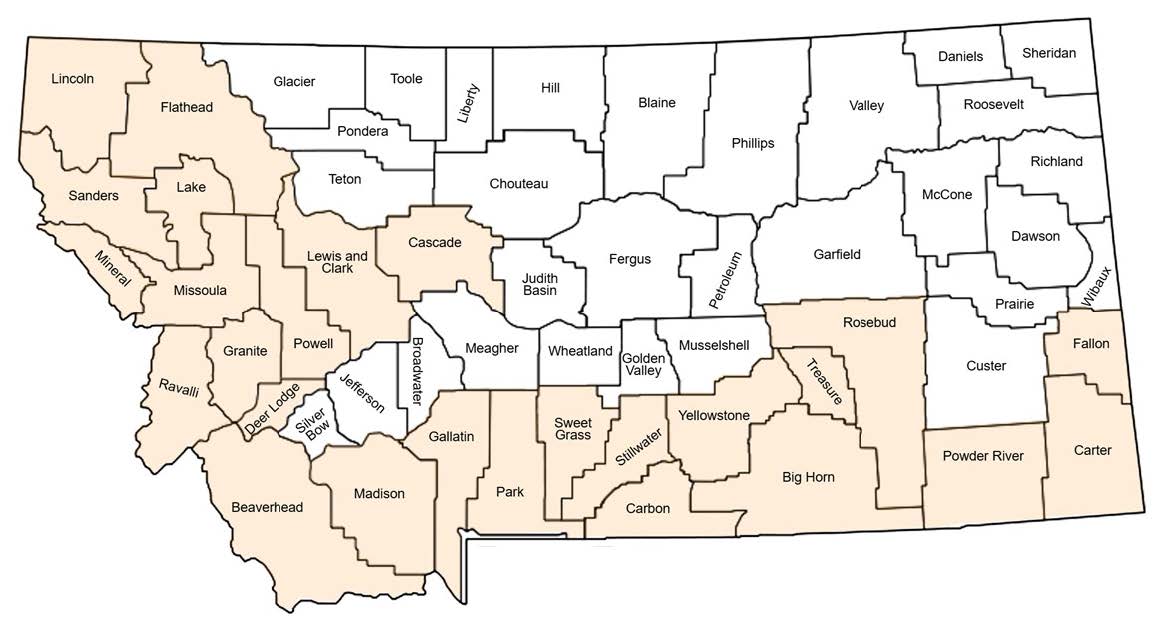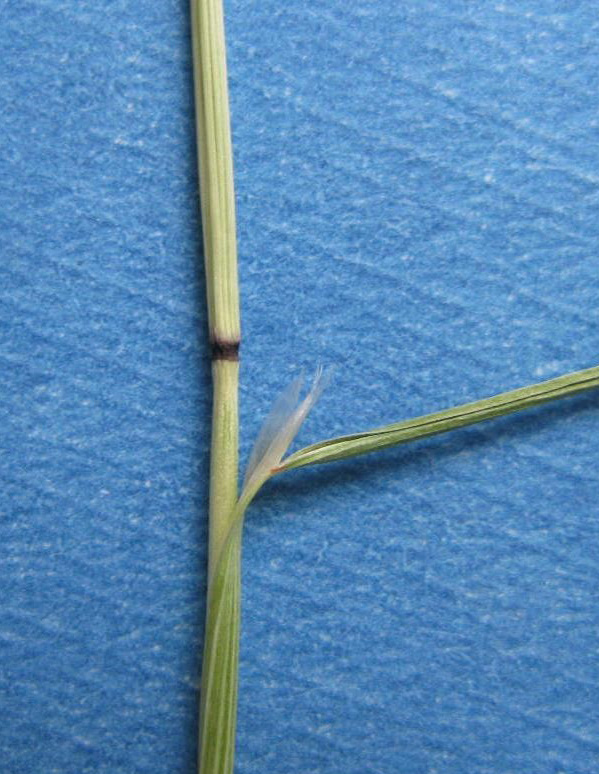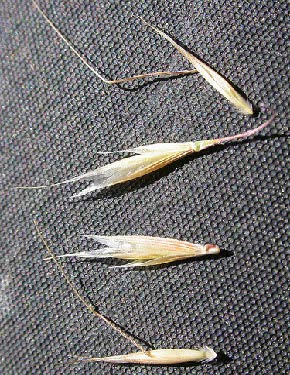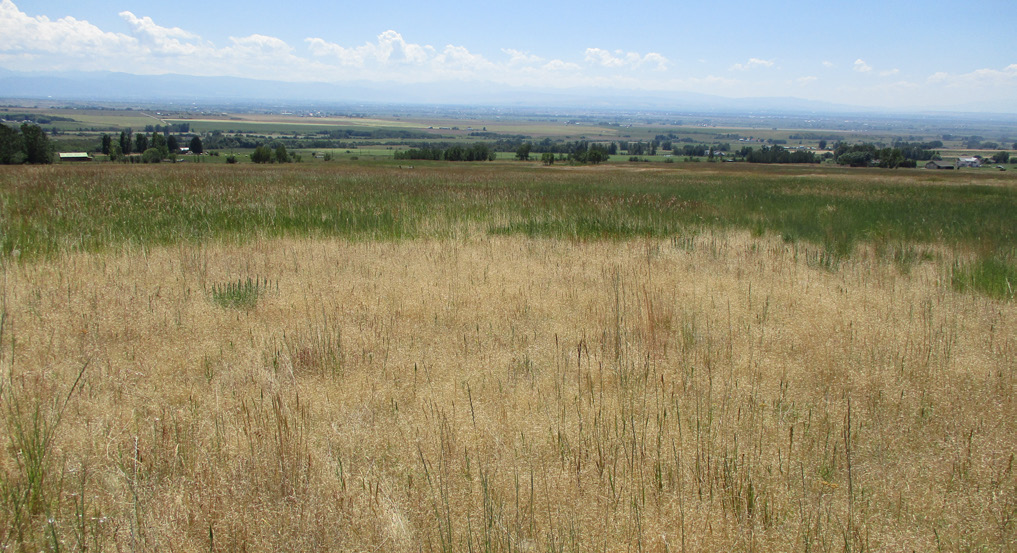High Priority Invasive Species: Ventenata
Agriculture and Natural Resources
MT201810AG
Revised March 2025
By Audrey Harvey and Jane Mangold, Department of Land Resources and Environmental Sciences
Invasive grasses such as ventenata may degrade plant communities and reduce suitable habitat for livestock and wildlife. Prevention and early detection can help slow the spread of new invaders and maintain weed-free areas. Contact your Extension agent or county weed coordinator for more information.
VENTENATA, ALSO KNOWN AS WIREGRASS OR NORTH African grass, is a non-native winter annual grass that is relatively new to Montana and has the potential to impact range, pasture, wild lands, and annual crops. Its low forage value and shallow root structure can lead to decreased agricultural production and increased risk of soil erosion.
Species name: Ventenata dubia (Leers) Coss. Family: Poaceae
History and status: Ventenata originates from southern Europe, western Asia, and northern Africa and was first found in North America in the early 1950s in Washington and Idaho. Ventenata was first documented in Montana in the mid-1990s. Montana listed ventenata as a Priority 2A noxious weed in 2019 due to known infestations and continual spread in native rangeland, pastures, and along roadsides. Isolated infestations occur from western Montana through southern Montana (Figure 1).

Figure 1. Counties in Montana where ventenata has been reported.
Identification: Ventenata is a winter annual grass that typically grows 6-18 inches tall. It has a distinguishing long, membranous ligule (up to 0.3 inches in length) with reddish-black nodes along the stem (Figure 2). Seedlings and mature leaves are narrow and folded lengthwise. Open and airy panicles emerge in late May through June (above photo), at which time the stems noticeably harden. Ventenata seeds have bent and twisted awns (Figure 3), similar to other species in the Avenaceae tribe, like wild oat (Avena fatua). The awns are developed, bent and twisted by July, reaching about 0.1 inch in length.

Figure 2. Reddish-black node and long, membranous ligule of ventenata. Photo: Tim Prather, University of Idaho.
Not to be confused with: Cheatgrass or downy brome (Bromus tectorum) and Japanese brome (B. japonicus). At the seedling stage, the leaves of cheatgrass and Japanese brome seedlings are twisted and hairier than ventenata. Ventenata seedlings emerge later and are thinner, more needle-like. At maturity, ventenata has awns like cheatgrass and Japanese brome but awns of ventenata are bent. Ventenata’s panicle is upright and open in contrast to the drooping panicles of cheatgrass and Japanese brome. In addition, cheatgrass turns reddish-purple upon maturity while ventenata remains green to tawny brown. Ventenata can also be confused with the native grass, annual hairgrass (Deschampsia danthonioides), which has similar open and airy panicles with bent awns. It may be found overlapping with ventenata in wetter areas, particularly in western Montana.

Figure 3. Seeds have bent awns. Photo: Tim Prather, University of Idaho.
Habitat: Ventenata mostly germinates in fall, but some germination can take place in spring. It is adapted to characteristic Mediterranean climates with cool, wet winters and hot, dry summers. Ventenata can invade rangeland, pastures, winter grain and hay fields, Conservation Reserve Program lands, and sagebrush steppe habitats (Figure 4). Field observations suggest it can grow in areas with moderate annual precipitation ranging from 14 to 44 inches and elevations ranging from 33 to 5,900 feet.

Figure 4. Ventenata can invade pastures, reducing forage production. Photo: Jane Mangold, MSU.
Spread: Ventenata reproduces by seeds. Each plant produces about 15-35 seeds. Dense stands of ventenata can produce from 2,800 to 3,700 seeds/ft2. It is known to spread via roadways and contaminated forage. Contaminated seed and hay as well as vehicles and equipment are suspected as a major source for infestations in Montana. Seeds can easily attach to fur, clothing, and machinery. Some canyon grasslands in Idaho that were once dominated by cheatgrass are now infested by ventenata, and in sagebrush steppe communities, ventenata is associated with medusahead infestations.
Impacts: Of the five known species in the genus Ventenata, V. dubia is the only one established in North America. Particularly in the Intermountain Pacific Northwest, it has caused substantial ecological and economic impacts in perennial grass habitats. Ventenata is generally unpalatable for livestock and wildlife and can decrease forage value. Additionally, the shallow root system creates conditions conducive to soil erosion. In Idaho an estimated reduction of 50 perecent forage yield and crop quality occurred a few years after initial infestations.
Management: Foremost, maintaining healthy productive stands of perennial grasses and early detection of infestations can limit invasion by ventenata. Mowing has limited success for small infestations as the wiry grass is difficult to cut and a second flush of seeds may occur. Grazing is not an option as livestock avoid the grass due to its high silica content and thin wiry stature.
The active ingredients indaziflam (Rejuvra®), imazapic (Plateau, Panoramic 2SL), sulfosulfuron (Outrider®), and rimsulfuron (Matrix®, Laramie 25DF) are chemical options for controlling ventenata. In a field trial in southwestern Montana, a single application of indaziflam resulted in over 90 percent control of ventenata over six years and evidence showed the single application depleted the seed bank during that time. Other research in Montana has shown products containing imazapic or rimsulfuron are also effective for providing shorter-term control. Some injury to perennial grasses can occur with these treatments and bare ground created by ventenata control can create openings for potential plant community changes. Further research is underway and mangement recommendations will continue to be refined.
Additional resources
plants.usda.gov/plant-profile/VEDU
fs.usda.gov/database/feis/plants/graminoid/vendub/all.html
Mangold, J. M., Sencenbaugh, L., Harvey, A. J., Rebis, M. E., Rew, L. J. Responses of Ventenata dubia and other species seven years after herbicide applications to an improved pasture in Montana. Invasive Plant Science and Management. 2024; 17(3):208-218. doi:10.1017/ inp.2024.20.
Acknowledgements
Dr. Tim Prather (University of Idaho), Bryce Christiaens (Missoula County Dept. Ecology and Extension), Jesse Scott (Carter County Weed District, former), and Damian Stoy (Montana State University) provided reviews o f this publication.
|
If you suspect that you may have found Ventenata, contact the Montana Department of Agriculture, your Extension agent or county weed coordinator, or the Montana State University Schutter Diagnostic Lab, montana.edu/extension/diagnostics. |
To download more free online MontGuides or order other publications, visit our online catalog at store.msuextension.org, contact your county or reservation MSU Extension office, or e-mail orderpubs@montana.edu.
Copyright © 2025 MSU Extension
We encourage the use of this document for nonprofit educational purposes. This document
may be reprinted for nonprofit educational purposes if no endorsement of a commercial
product, service or company is stated or implied, and if appropriate credit is given
to the author and MSU Extension. To use these documents in electronic formats, permission
must be sought from the Extension Communications Director, 135 Culbertson Hall, Montana
State University, Bozeman, MT 59717; E-mail: publications@montana.edu
The U.S. Department of Agriculture (USDA), Montana State University and Montana State University Extension prohibit discrimination in all of their programs and activities on the basis of race, color, national origin, gender, religion, age, disability, political beliefs, sexual orientation, and marital and family status. Issued in furtherance of cooperative extension work in agriculture and home economics, acts of May 8 and June 30, 1914, in cooperation with the U.S. Department of Agriculture, Cody Stone, Director of Extension, Montana State University, Bozeman, MT 59717.

